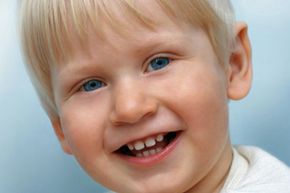Mammals have evolved through time as omnivores, which, as you probably know, means we eat both plants and animals. Because of the variety of foods we eat, each of our teeth performs a specific function in our mouth to help transition our food into digestible proportions. Our incisors are the front teeth with flat bottoms that do the bulk of the biting and cutting our food. Our canines (the top two of which are known as eyeteeth in humans because they're located directly below our eyes) are the four pointed teeth located next to our incisors. They're used for tearing and shredding food, especially meat, so they're built to be quite the workhorses. And then, rounding out the jaw line, are our premolars and molars, which do the bulk of the chewing of our food, hence their large, flat surfaces.
Our baby teeth, also known as our deciduous teeth, perform the same functions as our adult set, though on a much smaller scale. Though deciduous teeth do fall out sooner rather than later, they still have big responsibilities because they determine the spacing and alignment for the permanent teeth that follow.
Advertisement
Not all mammals have the same number of teeth in their mouths, because as they evolve and adapt to their environments, they lose teeth that no longer serve a purpose. Dental formulas help identify the types of teeth and the number of each kind of teeth at a glance. Upon first study, these formulas resemble complicated math problems, but really, they're quite simple if you know how to decode them. Let's take a look at the formula for deciduous teeth.
Deciduous: 2102/2102 = 10
This formula provides shorthand for the types of teeth in the mouth in this order: incisors (I), canines (C), premolars (P) and molars (M). It only covers teeth on one side of the mouth and is written to look like a fraction, with the upper teeth listed above the lower teeth. What this lets us know is that there are two incisors, one canine and two molars in the upper and lower half of one side of the mouth in a set of deciduous teeth. If you want to account for all of the teeth in a mouth, you have to multiply it by two. So what's the main difference between the formula for deciduous teeth and permanent teeth? Deciduous teeth don't have any premolars, hence the 0 listed in the formula above.
Advertisement

